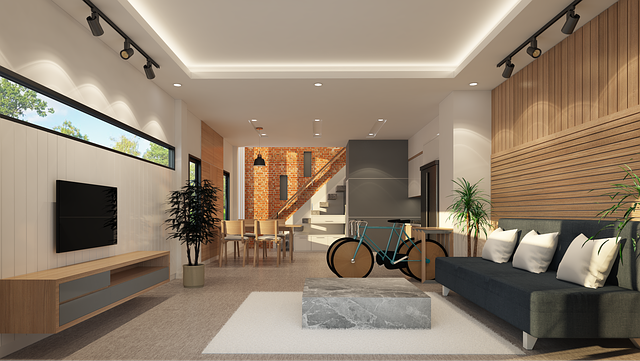UI design is the strategic arrangement of digital platform elements to provide a seamless, intuitive user experience, balancing functionality and aesthetics. Key aspects include simplicity, consistency, and user engagement through feedback mechanisms. A strong visual identity, adherence to usability heuristics, UX research, prototyping, and accessibility are crucial for effective UI design. Current trends, such as minimalism, AI integration, micro-interactions, and voice user interfaces, drive a future of personalized, intuitive, and immersive web design powered by cutting-edge technology.
“Unleash the power of effective UI/UX design and transform ordinary websites into exceptional user experiences. This comprehensive guide explores the intricate elements that drive engagement, from understanding foundational UI principles to implementing accessibility considerations. Discover key strategies for creating visually cohesive interfaces, optimizing usability, and leveraging research-backed methods. Learn how iterative prototyping and testing ensure seamless navigation while fostering inclusive design. Dive into these insights to master modern web UI design trends.”
Understanding UI Design: The Foundation of User Engagement

UI design forms the very foundation of user engagement with any digital platform, be it a website or an app. It’s not just about aesthetics; it’s the strategic arrangement of elements on a screen to create a seamless and intuitive experience for users. Think of it as the user’s first impression of a website—a split-second decision that can make or break their interest in exploring further. Effective UI design considers user behavior, tasks they’re trying to accomplish, and adapts these insights into visually appealing interfaces.
At its core, UI design focuses on ensuring that every element serves a purpose, from buttons and forms to typography and color schemes. It’s about guiding users through the website, making navigation intuitive, and presenting content in a way that aligns with their mental models. By striking the right balance between functionality and aesthetics, UI design fosters user engagement, encourages conversions, and ultimately contributes to the overall success of any digital product.
Key Principles of Effective UI Design

Effective UI design hinges on a few key principles that create engaging and user-friendly experiences. Firstly, simplicity is paramount. Clean, intuitive layouts with minimal clutter allow users to navigate effortlessly, focusing on content rather than design distractions. This clarity fosters confidence, encouraging users to explore further. Secondly, consistency across the entire website builds familiarity, making interactions predictable. Consistent use of color palettes, typography, and interactive elements guides users seamlessly through various pages, enhancing overall usability.
Additionally, feedback mechanisms provide users with a sense of control and engagement. Visual cues like loading indicators or confirmation messages assure users their actions are registered, building trust. Responsive design, ensuring the website adapts flawlessly to different screen sizes, is equally vital. This adaptability caters to diverse user needs, from desktop browsing to mobile on-the-go access, solidifying a positive UI design that resonates across platforms.
Creating a Cohesive Visual Identity

In UI design, establishing a cohesive visual identity is paramount to creating an engaging and user-friendly website. This involves carefully selecting and implementing a consistent color palette, typography, and imagery that reflect the brand’s essence. A unified visual language ensures that every element on the page, from buttons to navigation menus, contributes to a harmonious overall experience. By maintaining this consistency, users can navigate the site intuitively, as they become familiar with its visual cues.
A cohesive visual identity also aids in establishing trust and credibility with the audience. Users are more likely to engage with and remember a website that presents itself in a polished, integrated manner. This is particularly crucial in the competitive digital landscape where user attention is constantly vying for capture. Effective UI design, through its visual identity, helps differentiate a website from its competitors, fostering a positive first impression and encouraging users to explore further.
Usability Heursistics for Seamless Navigation

In the realm of UI/UX design, usability heursistics play a pivotal role in crafting seamless navigation for websites. These guiding principles help users intuit their way through a site’s interface, ensuring a frictionless experience from first click to final action. By following best practices like keeping navigation consistent across pages, using clear and descriptive labels, and organizing content logically, designers can create intuitive paths that empower users to achieve their goals efficiently.
Effective UI design prioritizes simplicity and predictability. Users should never feel lost or confused while navigating a website. Heuristics such as visual cues, hierarchical structures, and consistent layouts reinforce user expectations, fostering a sense of control and confidence. This translates into higher user satisfaction, reduced bounce rates, and increased conversion probabilities—key metrics that underscore the importance of usability heursistics in successful UI design.
UX Research Methods to Inform Design Decisions

UX research is a vital component of effective UI design, offering valuable insights that can shape and enhance user experiences. By employing various methods, designers can gather data, understand user behaviors, and identify pain points. This process involves observing users interacting with prototypes or existing websites, conducting interviews to gain qualitative feedback, and analyzing quantitative data such as clickstreams and user analytics.
These research techniques allow designers to make informed decisions about information architecture, wireframing, and visual design elements. For instance, understanding how users navigate a site can reveal the need for better labeling or re-organizing content. User interviews might uncover hidden desires or frustrations, guiding the addition of new features or streamlining existing ones. Integrating UX research into UI design ensures that the final product not only looks appealing but also meets user needs efficiently and effectively.
Prototyping and Testing: Iterative UI/UX Refinement

Prototyping is an integral part of the UI/UX design process, as it allows designers to bring their concepts to life and visually represent the user experience. By creating interactive prototypes, designers can gather valuable feedback from users early on in the development cycle. This iterative testing and refinement process ensures that the final product aligns closely with user expectations and desired outcomes. Through prototypes, designers can identify pain points, refine interactions, and enhance overall usability before investing significant resources into coding and implementation.
User testing plays a pivotal role in this cycle, providing insights into how real users interact with the interface. This feedback loop encourages designers to make informed decisions, ensuring that each touchpoint in the user journey is optimized for satisfaction and ease of use. The iterative nature of UI/UX design means that prototypes are not set in stone; they evolve based on user feedback, leading to a more intuitive and engaging website or web application.
Accessibility Considerations for Inclusive Design

In the realm of UI/UX design, accessibility is a cornerstone of inclusive design, ensuring that digital spaces are usable by people with diverse abilities. Effective UI design takes into account various impairments, including visual, auditory, motor, and cognitive disabilities. For instance, incorporating features like alt text for images, captions for videos, and keyboard navigability allows users relying on assistive technologies to interact seamlessly.
By adhering to accessibility guidelines such as WCAG (Web Content Accessibility Guidelines), designers can create websites that are not only compliant but also welcoming to a broader audience. This involves thoughtful design choices, like using semantic HTML, providing clear content structures, and ensuring color contrast meets recommended standards. These considerations not only enhance the user experience for individuals with disabilities but also benefit all users by fostering a more intuitive and inclusive digital environment.
Future Trends Shaping Web UI/UX Design

The future of UI/UX design for websites is being shaped by several emerging trends that promise to enhance user experiences and push creative boundaries. One prominent trend is the rise of minimalism, which focuses on clean lines, ample white space, and a reduced color palette. This approach not only improves readability but also makes interfaces more intuitive and accessible. Additionally, the integration of artificial intelligence (AI) and machine learning is transforming web design by enabling personalized experiences through adaptive layouts and smart content recommendations.
Another notable trend is the increasing emphasis on micro-interactions and animated elements, which add subtle visual feedback and make user journeys more engaging. Voice user interfaces (VUIs) are also gaining traction, especially with the growing popularity of virtual assistants. These trends point towards a future where web design becomes more intuitive, personalized, and immersive, catering to users’ preferences and behaviors in innovative ways while leveraging cutting-edge technologies.
